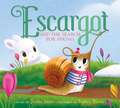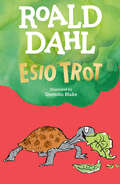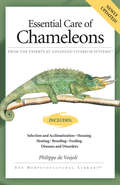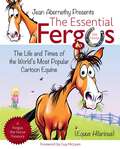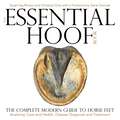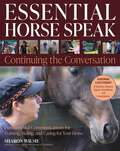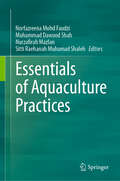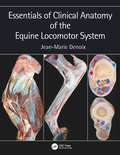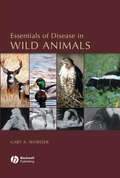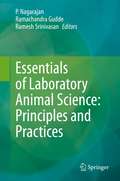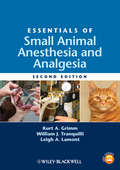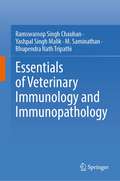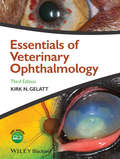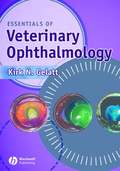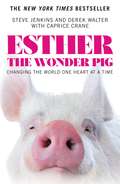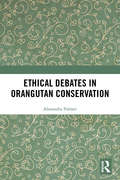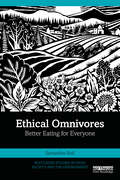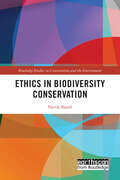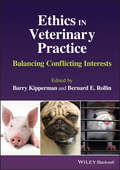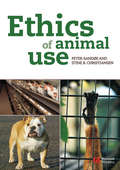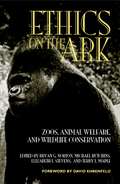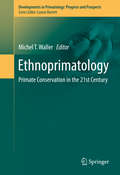- Table View
- List View
Escargot and the Search for Spring (Escargot)
by Dashka SlaterA cute French snail sets off on a springtime adventure with an adorable bunny in this laugh-out-loud fourth picture book in the bestselling Escargot series—the perfect gift for Easter or all year round. Bonjour! After a long winter spent indoors, Escargot can’t wait to look outside for the first signs of Spring. Will he find a new friend in the fluffy white bunny he meets along the way? From New York Times–bestselling author Dashka Slater and former Pixar animator Sydney Hanson, Escargot and the Search for Spring is an irresistibly sweet and charming story about unlikely friendship, changing seasons, and springtime fun. This hilarious and interactive addition to the award-winning Escargot series is the ideal read aloud for story time and animal lovers alike. Don’t miss Escargot’s other funny and heartwarming adventures for kids ages 4-6 in: ● Escargot (also available as a board book for babies and toddlers up to 3 years old)● A Book for Escargot● Love, Escargot (also available as a board book for babies and toddlers up to 3 years old)
Esio Trot
by Roald DahlFrom the bestselling author of Charlie and the Chocolate Factory and The BFG! Mr. Hoppy is in love with his neighbor, Mrs. Silver; but she is in love with someone else—Alfie, her pet tortoise. With all her attention focused on Alfie, Mrs. Silver doesn&’t even know Mr. Hoppy is alive. And Mr. Hoppy is too shy to even ask Mrs. Silver over for tea. Then one day Mr. Hoppy comes up with a brilliant idea to get Mrs. Silver's attention. If Mr. Hoppy's plan works, Mrs. Silver will certainly fall in love with him. After all, everyone knows the way to a woman&’s heart is through her tortoise.
Essential Care of Chameleons
by Philippe De VosjoliChameleons are fascinating creatures-they have eyes capable of moving independently of one another, a projectile tongue that allows them to capture insects from a distance, and a prehensile tail that helps keep them stable when climbing trees and shrubs. The Essential Care of Chameleons is packed with everything you need to know on selecting, acclimating, housing, and feeding a chameleon. You'll also find a special section on caring for the more popular species, including tips on how to overcome problems with diseases and disorders. Whether you are just thinking about getting a chameleon or are an experienced breeder, this book offers the most up-to-date information on all your chameleon needs.
Essential Fergus the Horse
by Jean AbernethyIn the late 1990s, a little bay horse with white socks and a blaze was born. Dubbed &“Fergus,&” he has now traveled the world many times over by print, web, and satellite, inspired a line of merchandise, and gained a devoted following in the hundreds-of-thousands on Facebook and other social media. Who is this horse and how can we explain his magnetism? What makes him so special? Fergus the Horse (Equus hilarious) is the creation of Jean Abernethy, and the truth is, he isn&’t meant to represent any one breed or discipline. Perhaps it&’s this generic &“everyhorse&” quality that&’s led to his popularity. &“When fans write, &‘Fergus reminds me of my horse,&’ I cannot be paid a higher compliment,&” says Abernethy. And it&’s his expressiveness, honesty, charm, and keen sense of humor that truly wins our hearts. Now Abernethy has brought together the backstory of Fergus the Horse—how he came to be, his early years, the history of his &“friends&”—and combined it with his &“greatest hits,&” including most-loved comic strips, some personal sketches, and brand new additions. The result is a lively, colorful, highly illustrated treasury that will entertain anyone with an eye for a horse and a need for a laugh.
Essential Hoof Book
by Susan Kauffmann Cline ChristinaThe equine hoof is a complex marvel of natural engineering, built to withstand tremendous forces and able to adapt to an astonishing range of environmental conditions. It also changes daily–for better or for worse–in response to external and internal factors. Few horse owners have the opportunity to acquire a deep understanding of the hoof, which limits their ability to advocate on their horses&’ behalf and make informed decisions about hoof care and management. This book is the first resource of its kind to combine the most current and useful information available, gleaned from the research and wisdom of top hoof experts around the world, with a unique &“hands-on&” approach. The authors provide basic terms and anatomy, clearly illustrate the differences between healthy and unhealthy feet, discuss biomechanics and management concerns, and cover the causes, treatments, and prevention of commonly encountered problems, including laminitis, white line disease, and thrush. Along the way, readers are given activities to help them better analyze and understand the most important aspects of equine hoof health, such as hoof balance, depth of sole, and point of breakover. Easy–to–follow language, over 400 full–color photographs, and do–it–yourself exercises promise to empower horse owners and caretakers of all experience levels with the tools they need to accurately assess hoof health and keep their horses as sound and happy as possible.
Essential Horse Speak
by Sharon WilsieThe most complete guide available to understanding the horse's language, knowing how to &“talk&” back, and to using Horse Speak® principles in any training system. In 2016 Sharon Wilsie's Horse Speak: The Equine—Human Translation Guide broke new ground for anyone who works with horses, providing a practical system to &“listening&” and &“talking&” to horses in their language instead of expecting them to understand ours. Now Wilsie has provided the most complete guide to Horse Speak ever. Those familiar with Wilsie's work will find novel ideas that have developed since the first book was released, and those new to Horse Speak will be supported with fundamental lessons that will allow them to start having authentic &“conversations&” with their horses during their very next trip to the barn. With a focus on how horse training methods in general can be improved with certain small changes in movement and mindset, Wilsie has once again created a resource of immense value across the equestrian spectrum. Solidify basic language skills—General Horse Speak fundamentals, plus new discoveries. Observe the horse's environment and movement signals—The &“Chessboard of Life&” and how horses negotiate it. Know the Buttons and what they do—The 15 communication centers on the horse's body, plus new connections and Conversations. Understand herd dynamics and your horse's type—Personality and energy types to assist you in understanding the role your horse is playing in his daily interactions. Explore the circular nature of horse Conversations—How the Four Gs and IINN help you remember where you are in a Conversation with your horse. Start the Conversation outside the box—Safe and effective ways to initiate connection and source breakthroughs from a distance and in environments other than arenas. Invite the horse to come with you—Best practices for haltering, leading, and backing up in hand so it is less challenging and a more rewarding experience for both you and your horse. Advance your body language at liberty and on the longe line—Keys to developing the rapport we desire with a horse by understanding his balances and imbalances on the ground. Ride with a new perspective—Take all that you have learned about communicating with the horse on the ground and bring it to your shared experience in the saddle. PLUS, use the one-of-a-kind Dictionary of Horse Speak to find out how to know what your horse is telling you, how to say things in reply to him, and how Horse Speak can help you fix common training and behavior problems. With illuminating sections on basic handling, groundwork, and ridden work, Wilsie gives readers everything they need to improve the training techniques they already use by enhancing both horse and human understanding of the process and the goals. The result is improved behavior, enhanced performance, and a happier, healthier equine partner in whatever you choose to pursue together.
Essentials of Aquaculture Practices
by Muhammad Dawood Shah Norfazreena Mohd Faudzi Nurzafirah Mazlan Sitti Raehanah Muhamad ShalehAquaculture is expanding along with the increase in demand for animal protein and hence significantly contributes to food security and socioeconomic livelihood. This book gathers current principles of aquaculture that are applied and practiced globally. It covers crucial topics including site selection, breeding and husbandry techniques, nutrition, health management, biosecurity, and sustainability. Furthermore, aquaculture's impact on food production and the economic values generated by the industry are also explored. While emphasizing the significance of environmental sustainability, this book encourages practices that minimize negative impacts on the ecosystem and preserve the health of our oceans. As a collection of reviews on the current practices in aquaculture, this book is a resource for individuals working in or interested in the industry. It also serves as a reference and guideline for students, researchers, and aquaculture operators.
Essentials of Clinical Anatomy of the Equine Locomotor System
by Jean-Marie DenoixKey features: <li>Important features of regional and topographical anatomy are presented using full-color photos of detailed dissections <li>Anatomy is presented in a clinical context <li>Preparations of cross-sectional anatomy facilitate interpretation of diagnostic imaging, such as ultrasonography, MRI images and CT scans <li>All dissections are of fresh material, rather than preserved specimens, to demonstrate the appearance of tissues in the living animal, or at post mortem autopsy <P><P>Essentials of Clinical Anatomy of the Equine Locomotor System presents a unique photographic record of dissections showing the topographical anatomy of the locomotor system of the horse. Readers of this book will be able to see the position and relationships of the bones, joints, muscles, nerves and blood vessels that make up each region of the forelimb, vertebral column and hindlimb. This new atlas is essential for anybody involved in detailed anatomical study, complex lameness evaluation or advanced imaging techniques in horses. It will be a useful guide for veterinary students, and a reference for equine vets in practice.
Essentials of Disease in Wild Animals
by Gary A. WobeserThe interrelationship between wild animal, domestic animals and human health is appreciated now more than ever before. This is because of the recognition of the involvement of wild animals in diseases of humans and domestic animals, the impact of disease on wildlife management and conservation biology, recognition of new forms of environmental contamination, and academic interest in disease as an ecological factor. This is the first introductory level book about disease in wild animals that deals with basic subjects such as the nature of disease, what causes disease, how disease is described and measured, how diseases spread and persist and the effects of disease on individual animals and populations. In contrast to authors of many other veterinary books, Gary A. Wobeser takes a more general approach to health in wild animals, recognizing that disease is one ecological factor among many and that disease can never be considered satisfactorily in isolation. Rather than focus on individual causative agents and their effect on the individual animal, the emphasis is on why disease occurred, and on the complex interactions that occur among disease agents, the environment and host populations. Written by a leading researcher in wildlife diseases, this book will fill a knowledge gap for those called to work with disease in wild animals who lack experience or training in the general features of disease as they relate to wild animals. Veterinarians, ecologists, wildlife biologists, population biologists and public health workers will find this book invaluable.
Essentials of Laboratory Animal Science: Principles and Practices
by Ramesh Srinivasan P. Nagarajan Ramachandra GuddeThis book comprehensively reviews the anatomy, physiology, genetics and pathology of laboratory animals as well as the principles and practices of using laboratory animals for biomedical research.It covers the design of buildings used for laboratory animals, quality control of laboratory animals, and toxicology, and discusses various animal models used for human diseases. It also highlights aspects, such as handling and restraint and administration of drugs, as well as breeding and feeding of laboratory animals, and provides guidelines for developing meaningful experiments using laboratory animals.Further, the book discusses various alternatives to animal experiments for drug and chemical testing, including their advantages over the current approaches. Lastly, it examines the potential effect of harmful pathogens on the physiology of laboratory animals and discusses the state of art in in vivo imaging techniques.The book is a useful resource for research scientists, laboratory animal veterinarians, and students of laboratory animal medicine.
Essentials of Small Animal Anesthesia and Analgesia
by Kurt A. Grimm William J. Tranquilli Leigh A. LamontEssentials of Small Animal Anesthesia and Analgesia, Second Edition presents the fundamentals of managing small animal anesthesia patients in a clinically relevant, accessible manual. The bulk of the book is distilled from Lumb and Jones' Veterinary Anesthesia and Analgesia to provide authoritative information in a quick-reference format, with references to Lumb and Jones' throughout for easy access to further detail. Logically reorganized with an easy-to-use structure and an increased focus on pain management, this new edition features new chapters on equipment and managing specific conditions.The Second Edition has been updated to reflect current practices in anesthesia and analgesia, and a new companion website offers review questions and answers, video clips, and an image bank with additional figures not found in the printed book. Essentials of Small Animal Anesthesia and Analgesia, Second Edition provides veterinary care providers and students with key information on anesthetic and analgesic pharmacology, physiology, patient assessment, and clinical case management.
Essentials of Tortoise Medicine and Surgery
by Aidan Raftery John ChittyReach for this book whenever a sick or injured tortoise comes into the surgery. Essentials of Tortoise Medicine and Surgery is designed as a concise and practical quick reference for the busy practitioner seeing chelonians as part of their caseload. Covering everything from species identification to common basic surgery for tortoises and freshwater turtles, the emphasis is on the more common and likely diagnoses.The first section of the book gives an overview of the basics of tortoise and semi-aquatic/ aquatic freshwater turtle husbandry and keeping, as well as a guide to general investigation and diagnostic techniques open to clinicians. The second section provides a clinical guide based on clinical signs and differential diagnoses.Based upon the experience of authors who have been practicing with these species for several decades, this book is a useful guide to veterinarians, students, veterinary nurses and technicians new to working with these fascinating creatures. It will also serve as a useful aide memoire to more experienced clinicians.
Essentials of Veterinary Immunology and Immunopathology
by Yashpal Singh Malik Ramswaroop Singh Chauhan M. Saminathan Bhupendra Nath TripathiThis textbook for graduate veterinary students provides basic concepts of veterinary immunopathology with particular reference to immunopathogenesis. The initial chapters provide up-to-date knowledge on important aspects of immunology, immunodeficiency disorders, hypersensitivity reactions, and autoimmune disorders of various animal species. The book examines different natural and synthetic immunomodulatory products that can modulate the immune system of animals. It discusses the immunopathogenesis and immunopathology of multiple diseases and immunopathological disorders in diverse animal species, including cattle, buffalo, sheep, goat, swine, equine, and laboratory animals. The book also covers the immunopathology of various body systems, including lungs, reproductive system, enteric system, mammary gland, joints, kidneys, and skin. It provides clinical manifestations that are useful in diagnosing immunopathological conditions. The book presents a highly informative text with highquality gross and microscopic photographs, diagrammatic presentations of immunopathological disorders and techniques, making it useful in both classrooms and professional training courses for students, researchers, and professionals alike.
Essentials of Veterinary Ophthalmology
by Kirk N. Gelatt Caryn E. PlummerA user-friendly reference to basic, foundational information on veterinary ophthalmology This book provides readers with a user-friendly manual to the basics of veterinary ophthalmology. It puts a focus on the most relevant information for clinical practice. Emphasizing canine ophthalmology, the book also covers the foundations of feline, equine, farm animal, and exotic animal ophthalmology. To aid in reader comprehension and information assimilation, a companion website presents review questions and the figures from the book in PowerPoint. Sample topics covered within the work include: Ophthalmic foundations: ophthalmic development and structure, physiology of the eye and vision, and ocular pharmacology and therapeutics Canine ophthalmology: canine orbit (disease and surgery), canine eyelids (disease and surgery), canine lacrimal apparatus (tear secretion and drainage), canine cornea (diseases and surgery) and canine glaucoma Other species: feline ophthalmology, equine ophthalmology, and food and fiber animal ophthalmology Ophthalmic and systemic diseases: comparative neuro-ophthalmology and systemic disease and the eye Essentials of Veterinary Ophthalmology is a useful guide for veterinary students and practitioners looking to build out their core foundations of knowledge within their specific programs of study and disciplines.
Essentials of Veterinary Ophthalmology
by Kirk N. GelattEssentials of Veterinary Ophthalmology, Third Edition offers an updated introduction to the diagnosis and clinical management of ocular conditions in veterinary patients, providing trusted information in a user-friendly format. The content of the book is distilled from the fifth edition of the gold-standard reference Veterinary Ophthalmology, emphasizing the information most relevant to veterinary students and general practitioners. Fully updated throughout, the Third Edition focuses more strongly on small animals and horses, with streamlined coverage of other species, and new chapters have been added on morphology, physiology, and pharmacology. Carefully designed to be equally useful for learning and in practice, the book offers a streamlined, practical approach, with bolded terms to enhance comprehension. High-quality color photographs provide visual depictions of the conditions discussed. Essentials of Veterinary Ophthalmology, Third Edition is an indispensable resource for veterinary students or clinicians wishing to hone their ophthalmology knowledge and skills.
Essentials of Veterinary Ophthalmology (Second Edition)
by Kirk N. GelattNow in its second edition, Essentials of Veterinary Ophthalmology provides its readers with a practical introduction to the diagnosis and clinical management of the most frequently encountered eye diseases of domestic animals. Essentials of Veterinary Ophthalmology is distilled from the authoritative, two-volume, fourth edition of Veterinary Ophthalmology (Gelatt), drawing primarily on the clinically relevant sections to provide expert coverage in a more concise and quick-reference format - ideal for busy small animal or equine practitioners seeking rapid advice for a patient. The second edition includes more images, algorithms to speed the clinical problem-solving process, key points highlighted in bold, expanded appendices for convenient reference to therapeutic agents, recommended dosages, and possible side effects, and a brief glossary.Practical and accessible, the second edition of Essentials of Veterinary Ophthalmology is filled with reader-friendly features to provide veterinary students and practitioners with an indispensable resource for the fundamentals of clinical veterinary ophthalmology.* Focuses on the most common eye diseases of small animals and horses* Provides expert coverage in a concise, quick-reference format* New edition includes more images, algorithms, key points in bold, expanded appendices and glossary* Based on the two-volume definitive reference Veterinary Ophthalmology, 4th Edition (Gelatt)
Esther the Wonder Pig: Changing the World One Heart at a Time
by Steve Jenkins Caprice Crane Derek WalterUnlikely pig owners Steve and Derek got a whole lot more than they bargained for when the designer micro piglet they adopted turned out to be a full-sized 600-pound sow! In the bestselling tradition of pet memoirs such as Oogy, Dewey, and Giant George, the story of ESTHER THE WONDER PIG shows how families really do come in all shapes and sizes. In the summer of 2012, Steve Jenkins was contacted by an old friend about adopting a micro piglet. Though he knew his partner Derek wouldn't be enthusiastic, he agreed to take the adorable little pig anyway, thinking he could care for her himself. Little did he know, that decision would change his and Derek's lives forever. It turned out there was nothing "micro" about Esther, and Steve and Derek had actually signed on to raise a full-sized commercial pig. Within three years, Tiny Esther grew to a whopping 600 pounds. After some real growing pains and a lot of pig-sized messes, it became clear that Esther needed much more space, so Steve and Derek made another life-changing decision: they bought a farm and opened the Happily Ever Esther Farm Sanctuary, where they could care for Esther and other animals in need. Funny, heartwarming, and utterly charming, ESTHER THE WONDER PIG follows Steve and Derek's adventure--from reluctant pig parents to farm-owning advocates for animals.
Ethical Debates in Orangutan Conservation
by Alexandra PalmerEthical Debates in Orangutan Conservation explores how conservationists decide whether, and how, to undertake rehabilitation and reintroduction (R&R) when rescuing orphaned orangutans. The author demonstrates that exploring ethical dilemmas is crucial for understanding ongoing disagreements about how to help endangered wildlife in an era of anthropogenic extinction. Although R&R might appear an uncontroversial activity, there is considerable debate about how, and why, it ought to be practised. Drawing on in-depth qualitative research with orangutan conservation practitioners, this book examines how ethical trade-offs shape debates about R&R. For example, what if the orphan fails to learn how to be an orangutan again, after years in the company of humans? What if she is sent into the forest only to slowly starve? Would she have been better off in a cage? Could the huge cost of sending a rescued ape back to the wild be better spent on stopping deforestation in the first place? Or do we have a moral obligation to rescue the orphan regardless of cost? This book demonstrates that deconstructing ethical positions is crucial for understanding ongoing disagreements about how to help our endangered great ape kin and other wildlife. Ethical Debates in Orangutan Conservation is essential reading for those interested in conservation and animal welfare, animal studies, primatology, geography, environmental philosophy, and anthropology.
Ethical Omnivores: Better Eating for Everyone (Routledge Studies in Food, Society and the Environment)
by Samantha NollThis book provides a detailed overview of ethical omnivorism, as well as the philosophical foundations of this movement and diet.Many eaters are concerned about the impact that their food choices have on the environment, animals, and human health. Ethical omnivorism is at once a new food ethic, diet, and global movement aimed at providing a flexible path for eaters committed to bringing about lasting change one meal at a time. While publications in food ethics are largely dominated by vegetarian titles, this book explores the viability of omnivorism, a dietary choice which is not devoid of animal products, but one which embraces eating local, eating organic, and eating humanely raised food products. In doing so, this diet builds on the local food movement’s desire to know where food comes from and stresses the importance of maintaining high animal welfare and environmental standards. Overall, this book provides a foundational overview of ethical omnivorism as a food movement and guidance for those interested in eating ethically, while recognizing that many factors influence dietary choices.This book will be of great interest to students and scholars of food studies, food, agriculture and animal ethics, environmental philosophy, and those more widely interested in making ethical food choices.
Ethics and Animals
by Lori GruenReflects on our ethical obligations and responsibilities to other animals, encouraging readers to engage with the philosophical issues at stake.
Ethics in Biodiversity Conservation (Routledge Studies in Conservation and the Environment)
by Patrik BaardThis book examines the role of ethics and philosophy in biodiversity conservation. The objective of this book is two-fold: on the one hand it offers a detailed and systematic account of central normative concepts often used, but rarely explicated nor justified, within conservation biology. Such concepts include ‘values’ (both intrinsic, instrumental, and, more recently, relational), ‘rights’, and ‘duties’. The second objective is to emphasize to environmental philosophers and applied ethicists the many interesting decision-making challenges of biodiversity conservation. The book argues that a nuanced account of instrumental values provides a powerful tool for reasoning about the values of biodiversity. It also scrutinizes relational values, the concept of rights of nature, and risk, and show how moral philosophy proves indispensable for these concepts. Consequently, it engages with recent suggestions on normative aspects of biodiversity conservation, and show the need for moral philosophy in biodiversity conservation. The overriding aim of this book is to provide conservation biologists and policy-makers with a systematic overview of concepts and assessments of the reasons for reaching prescriptive conclusions about biodiversity conservation. This will prove instrumental in clarifying the role of applied ethics and a refined understanding of the tools it can provide. This title will be of interest to students and scholars of conservation biology, conservation policy, environmental ethics and environmental philosophy.
Ethics in Veterinary Practice: Balancing Conflicting Interests
by Bernard E. Rollin Barry KippermanEthics IN Veterinary Practice An incisive examination of relevant and contemporary ethical issues facing veterinary practitioners, students, instructors, and animal researchers In Ethics in Veterinary Practice: Balancing Conflicting Interests, a team of distinguished scholars delivers a foundational exploration of animal ethics and a guide to examining contemporary issues and dilemmas that arise regularly in veterinary practice. The book offers comprehensive, quickly accessible, and up-to-date information on veterinary ethics with content devoted to unique issues by practice type. The authors offer a primary resource for veterinary ethics useful for veterinarians, faculty, instructors, senior undergraduates, and veterinary students that focuses on recognizing and addressing real-life ethical dilemmas and relevant philosophical discussions about the moral status of animals, animal rights, and interests. Ethics in Veterinary Practice presents material on integrative medicine, animal pain, moral stress, and the future of veterinary ethics. Readers will also find: A thorough introduction to a theoretical basis for veterinary ethics, including discussions of animal welfare, ethical theories, and legal issues Comprehensive explorations of clinical veterinary ethics, including discussions of veterinary advocacy, ethical dilemmas, professionalism, economic issues, and medical errors Practical discussions of ethical concerns by practice type, including companion animals, equines, and animals used for food In-depth examination of emerging ethical concerns including animal use in veterinary education and animal maltreatment Perfect for practicing veterinarians, veterinary students, and veterinary technicians and nurses, Ethics in Veterinary Practice: Balancing Conflicting Interests will also earn a place in the libraries of instructors teaching veterinary ethics, as well as biomedical and animal ethicists.
Ethics of Animal Use
by Peter Sandøe Stine B. ChristiansenAn interesting and accessible introduction to ethical issues raised by various forms of human use of animals. This textbook avoids moral lecturing and presents a range of ethical viewpoints without defending or applying any specific stance. Readers are encouraged and provoked to reflect for themselves, and to sharpen their own points of view regarding the ethical limits on our use of animals. They will also gain further understanding of the views held by other people. Early chapters of this interdisciplinary book cover changes over time in our view of animals, the principles of animal ethics, and different views of what counts as a good animal life. Later chapters apply the conceptual tools to specific issues including: food animal production, advanced veterinary treatment of pets, control of infectious diseases, wildlife management, as well as the use of animals in research. Specifically designed for students of veterinary medicine, animal science, welfare and behaviour, and veterinary nursing. Also of interest to those wanting to combine an up-to-date, science-based account of animal issues with clear-headed moral reflection. "The book covers an impressive range of topics with accuracy and fairness. Despite its ambitious scope, the authors have achieved remarkable unity in the book, and have produced a book that is easy and pleasant to read. Their work will surely provide a major tool for rationalizing the debate about the ethics of animal use, and I commend them for their invaluable contribution." From the Foreword by Professor Bernard Rollin, Colorado State University.
Ethics on the Ark: Zoos, Animal Welfare, and Wildlife Conservation
by Terry Maple Elizabeth Stevens Michael Hutchins Bryan G. NortonEthics on the Ark presents a passionate, multivocal discussion--among zoo professionals, activists, conservation biologists, and philosophers--about the future of zoos and aquariums, the treatment of animals in captivity, and the question of whether the individual, the species, or the ecosystem is the most important focus in conservation efforts. Contributors represent all sides of the issues. Moving from the fundamental to the practical, from biodiversity to population regulation, from animal research to captive breeding, Ethics on the Ark represents an important gathering of the many fervent and contentious viewpoints shaping the wildlife conservation debate.From the Trade Paperback edition.
Ethnoprimatology
by Michel T. WallerThe list of challenges facing nonhuman primates in the 21st century is a long one. The expansion of palm oil plantations to feed a growing consumer class is eating away at ape and monkey habitats in Southeast Asia and Central Africa. Lemurs are hunted for food in the poorest parts of Madagascar while monkeys are used as medicine in Brazil. Traditional cultural beliefs are maintaining demand for animal body parts in West African markets while viral YouTube videos of "cute" and "cuddly" lorises have increased their market value as pets and endangered their populations. These and other issues are addressed in this book by leading researchers in the field of ethnoprimatology, the study of human/nonhuman primate interactions that combines traditional primatological methodologies with cultural anthropology in an effort to better understand the nuances of our economic, ritualistic, and ecologic relationships.
